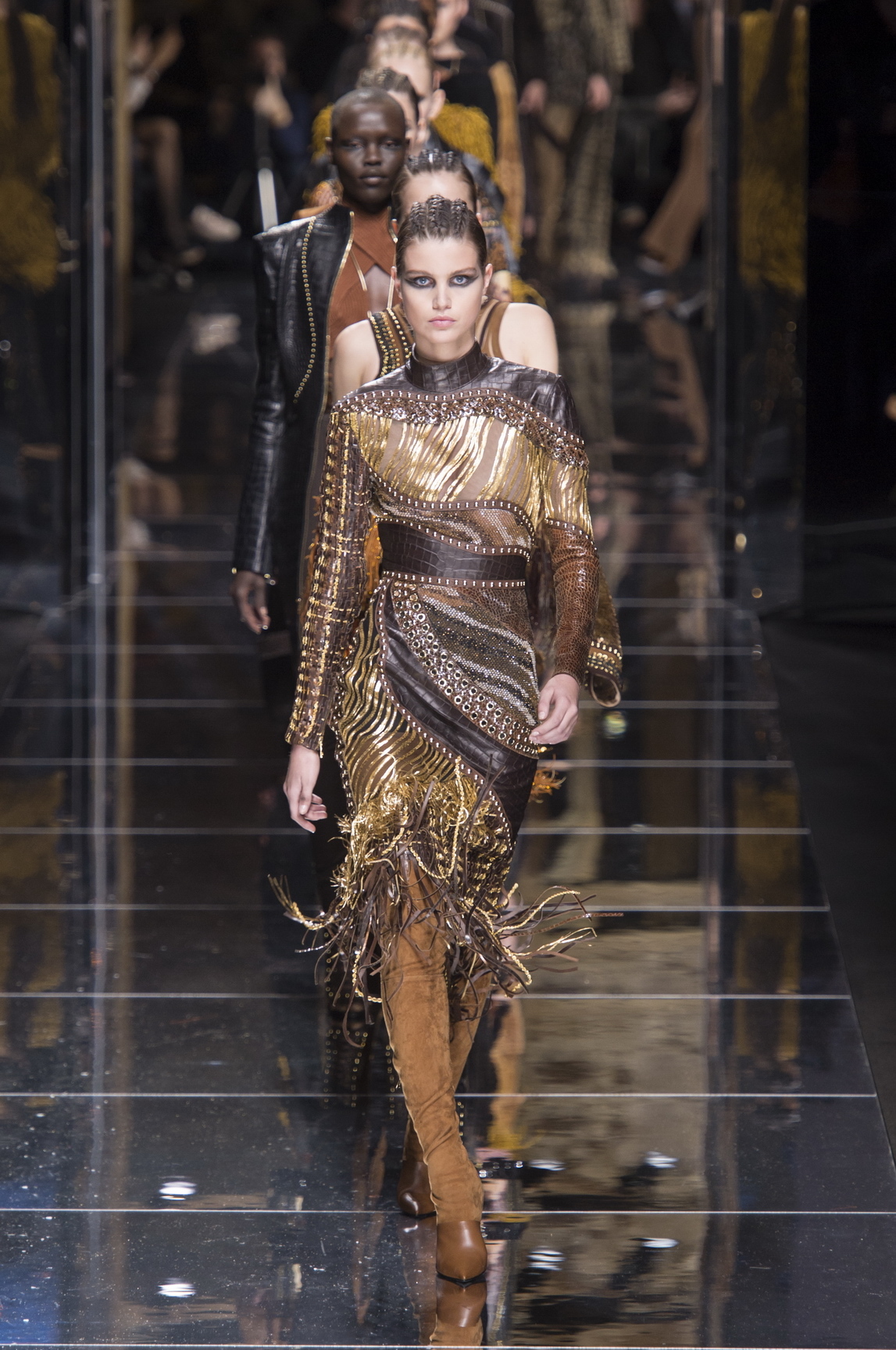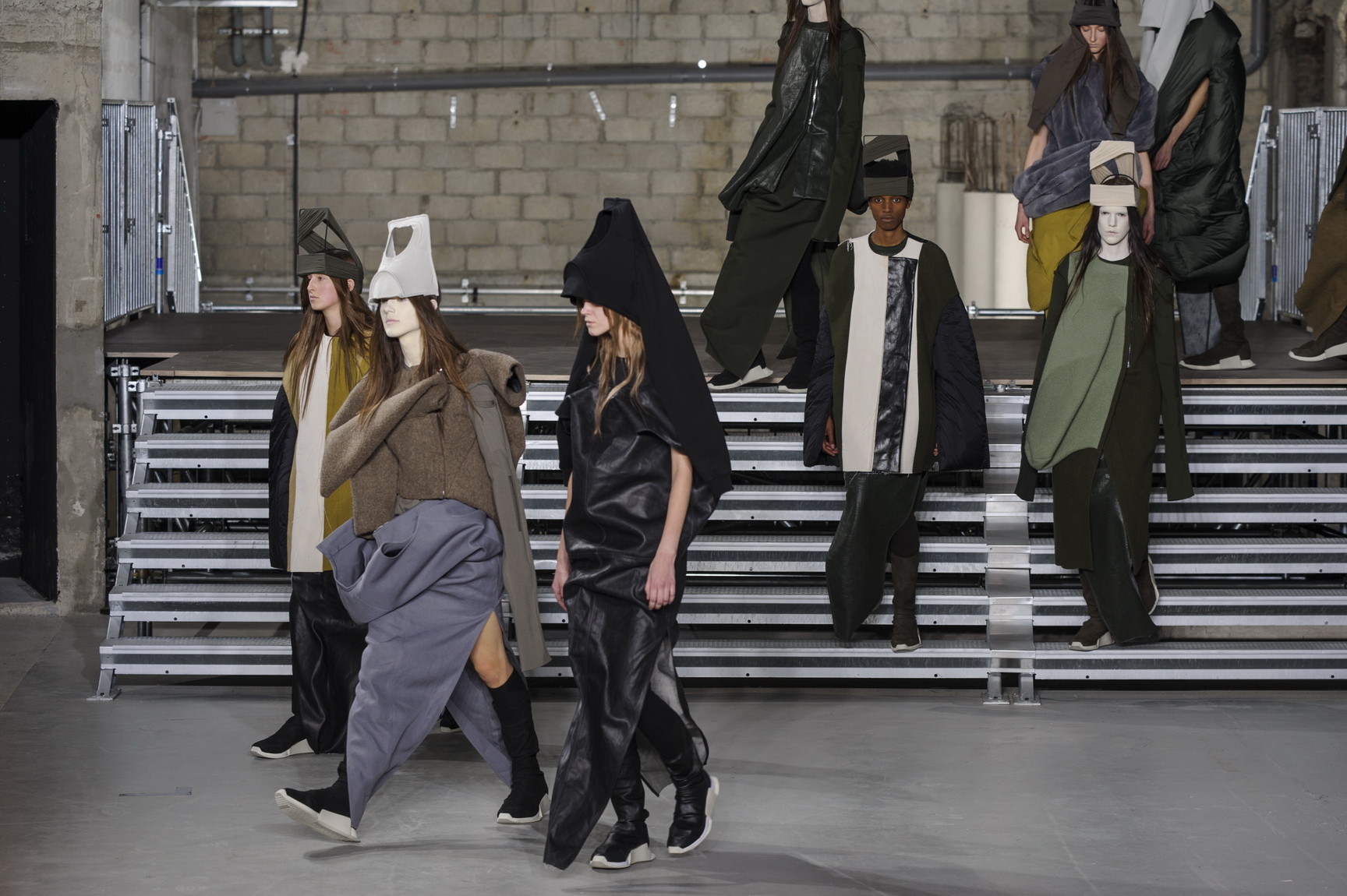Have you recently been victim to an earth-shattering 2016? Do you own your own home? Do you feel as if you’re owed emotional compensation for elections gone wrong? Well, the fall/winter 17 women’s season won’t be your insurance ad. If some turned up to these shows hoping for a little communal Weltschmerz in which to wallow, the anti-negativity observed amongst designers this season would leave them sorely disappointed. Unlike the play-dough therapy and kumbaya sessions that played out around American colleges in the wake of Trump’s victory, the women’s shows and their socially astute designers have been anything but a self-pity party for all of us fellow victims of 2016. Following in the footsteps of those life-affirming women’s marches in January, fashion’s message is hopefulness over hopelessness — from Prada to Versace and beyond. “I’ve been very gloom and doom for the past couple of seasons, which you might have picked up on,” Rick Owens smiled after his show, the light-as-porcelain Beethoven soundtrack (“Piano Sonata 31”) which had guests all pain-relieved and calm. He was referring to our interview in the i-D Fall 17 issue, a Death in Venice-fueled portrait of the designer lamenting a broken world from the solitude of his Lido summer home.

“So okay,” Owens reasoned. “After you complain and protest, what do you do? You pick yourself up and you try to create civilization in your own way.” He described his fall/winter 17 women’s collection as “improvised ceremony”: “Civilization is ceremonies. Ceremonies are about community. It’s about people pursuing the same values and ideals. So ceremony is a cornerstone of civilization.” You could argue there’s always a ceremonial quality to a Rick Owens show, kind of like going to church, but this one had an esoteric sense of purpose to it. Much like those women’s marches in January, Owens’s women were walking for a mutual cause, with all the regal pomp and circumstance that came with it. “Yeah, they’re crowns,” he said, describing the headpieces that characterized his styling, some equal parts fantastical creature and wartime trench accessory. “They look menacing, I know, but I thought in the context it would look like a ceremonial thing. Veils are also about privacy, which I think is a nice idea. Privacy is a big luxury for me.” The collection built on Owens’s shape-shifting men’s show in January, patch-working volumes and nature-centric colors into sizeable silhouettes that looked anatomical — human hearts on sleeves, you might say.

Where, in his men’s show, Owens used the 70s Glitter movement as a sentiment of protest against reactionary times, the image of glitter had now become a method of gilding the grey to him. “It’s now about the glitter of civilization,” he explained. “Ceremonies, hats; a sense of occasion.” Owens wasn’t sugar-coating reality, though, or trying to force a sense of optimism. “You know, I’m a realist. I was thinking, what is happening right now and what does it mean? I was never horribly pessimistic,” he said. “I told you the advice my dad gave me, which was really good: ‘Hope for the best, but plan for the worst.’ And I think that’s really the way I think. Like, it’s all gonna fall apart anyway.” If it sounded self-contradictory, it was simply Owens’s pragmatism shining through. He’s a no-nonsense kind of guy, but his outlook is fused with an acute sense of emotion fueled by his constant reflections on himself and his surrounding world. “I’m looking around realizing I have a human skull on my desk here and a human skull on my desk in Italy, and there’s something very simplistic about it because it’s very much like a memento mori, It’s very much about seize-the-moment, and one day my skull is going to be on somebody’s desk. It’s the realistic cycle of life.”

Translated into fashion’s rotation of designers and houses — how’s that for an inappropriate transition? — that cycle is reality, too. Hours before Owens’s show, Clare Waight Keller was having a ceremony of her own at Chloé — the farewell kind, or a ‘ceremony of separation’ as Rei Kawakubo titled her fall/winter 15 women’s collection. Pricelessly, Waight Keller took her final bow at the house to “Don’t You Want Me” by The Human League, cementing the twinkle-in-the-eye approach that’s really grown on her through her six years at Chloé. It was, of course, a conscious uncoupling — a term no doubt familiar to the women, who have made up Chloé’s clientele under Waight Keller’s lead. And they did want her. The designer has been successful at the house, balancing great sales with critical acclaim, and so it was an optimistic departure on her part, complemented by a spirited collection she said was psychedelic — well, as psychedelic as it gets within Chloé’s girly Rive Gauche chic. There’s a strong rumor here in Paris that Waight Keller is headed for Givenchy, which Riccardo Tisci departed after his last men’s show.
Read: From New York to London to Milan to Paris, check out all of i-D’s fall/winter 17 show coverage now.

If that’s the case, we’ll soon have a new ceremony on our hands — not just the inaugural kind, but a history-making one: the first female designer to step into Hubert de Givenchy’s countly shoes and carry on the little-black-dress legacy that epitomized Audrey Hepburn as a fashion icon. When the actress married Mel Ferrer in 1954, she wore a bridal gown designed by Pierre Balmain. Its almost medieval structure and gigot sleeves weren’t this season’s archival reference for the house’s current designer Olivier Rousteing, but his collection did have its share of Game of Thrones armorability, modeled — why of course — on the Hepburns of our time: social media model superstars Kendall Jenner and Gigi Hadid, whose brooding boyfriend Zayn Malik looked on courtside. “Here are we now, entertain us,” Kurt Cobain sang on the soundtrack: a ceremony for a post-modern youth. Virgil Abloh grew up as part of that and his collection of Thursday evening spoke volumes of it. “Nothing new,” he called his check-tastic collection for the sophisticated millennial in an almost nihilistic statement about fashion and our times. It wasn’t perhaps an optimistic sentiment, but like Owens reminded us, a realistic take on what we’re all going through is all we really need.

Credits
Text Anders Christian Madsen
Photography Mitchell Sams
